
views
- Bathe, eat an odd number of dates, and recite the Takbir before you attend Eid Salah.
- Set your intention and follow the imam or act as your own imam as you pray through the first rak’ah, which involves the Dua al-Istiftah, Takbirs, a Quran recitation, and 2 Sujuds.
- Perform the second rak’ah by listening to the Surah Al Fatiha and a Surah, recitations of Takbirs and the Tashahhud, and 2 more Sujuds.
- Listen to the Khutbah, greet your family, and take a different route home after the second rak’ah.
Preparing for Eid Salah

Rise early and bathe yourself the morning of Eid Salah. Brush your teeth, wash your body, put on perfume, and wear your finest clothes to prepare yourself for Eid Salah. Take special care to look your most presentable. If you can, wear new clothes or ones that you only wear on special occasions. This is a special prayer and the way you prepare yourself for it is meant to be different from your ordinary habits.

Eat an odd number of dates before heading to the Eid ul-Fitr prayer. It’s customary to eat something sweet before going to perform Eid Salah, and the odd number is important because that is how the Prophet ate on the morning of Eid ul-Fitr. Do not eat before Eid ul-Adha. Instead, wait until after the prayer to break your fast.

Recite the Takbir as you make your way to Eid ul-Fitr. This focuses your mind and intentions on the prayer as you travel to the place of prayer. There’s a distinct Takbir for Eid, as opposed to the rest of the year, which is: “Allahu akbar, Allahu akbar, La ilaha illallah, Wallahu akbar, Allahu akbar wa lillahil hamd.” This means “Allah is the greatest, Allah is the greatest, there is no god but Allah. And Allah is the greatest, Allah is the greatest and to Allah belongs all praise.” The Takbir is the name for the Arabic phrase “Allahu akbar,” which means, “Allah is the greatest.”
The First Rak’ah
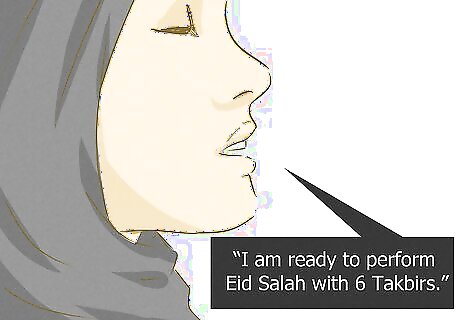
Set your intention in your heart for the Eid Salah prayer. Focus internally and think, “I intend to pray the Sunnah prayer of Eid al-Fitr [or of Eid al-Adha] 2 rak'ah for Allah ta'ala.” This prepares you to concentrate fully on performing Eid Salah. You can also say this verbally, though it is not required. Intentions are very important in Islamic tradition, and Muslims believe that they will be rewarded for their intentions as well as for their actions.

Follow the imam’s lead for the Eid Salah prayer. Even if you have a general idea for how the Eid Salah will progress, don’t move or speak before the imam has indicated it’s time to do so. Each imam will have their own pacing that they follow, even if the steps are the same. Your imam ill also indicate how many Takbirs will be said during the prayer, so listen closely. This shows that you are respectful of the imam and that you are focused on the moment. If you’re performing Eid Salah at home, act as your own imam, and conduct the prayer at whatever pace is comfortable for you.

Recite the first Takbirs and the Dua al-Istiftah. Raise your hands so that your thumbs are level with your earlobes and say “Allahu Akbar” after the imam does the same. After this, lower your hands (place your right hand over left in front of your chest) and recite the Dua al-Istiftah quietly to yourself. Then, the imam will then say “Allahu Akbar” 3 times. Repeat after him and raise your hands after each utterance. After you raise your hands, put them back down by your sides. The Dua al-Istiftah refers to the opening prayer of the salah. There are different duas to recite, but the most common is: سُبْحَانَكَ اللَّهُمَّ وَبِحَمْدِكَ وَتَبَارَكَ اسْمُكَ وَتَعَالَى جَدُّكَ وَلاَ إِلَهَ غَيْرُكَ (“Subhanaka Allahumma wa bihamdika wa tabarakasmuka, wa ta’ala jadduka wa la ilaha ghairuk”). The motion of raising your hands during a Takbir is known as “Takbiratul Ihram.”
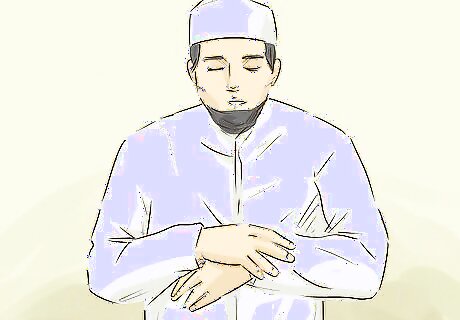
Put your hands in front of your chest as the imam recites the Quran. Place your right hand on top of your left hand. The imam will recite Surah Al-Fatiha and then an additional Suran. Listen carefully as he speaks and reflect on the words. After this, the first rak’ah will be completed as usual. Recite the Surah Al-Fatiha and additional Surah yourself if performing the Salah at home. The additional Surah can be any Surah from the Quran. You can also take this time to reflect on what Eid Salah means to you. Think about the words being recited from the Holy Quran and thank Allah for them.
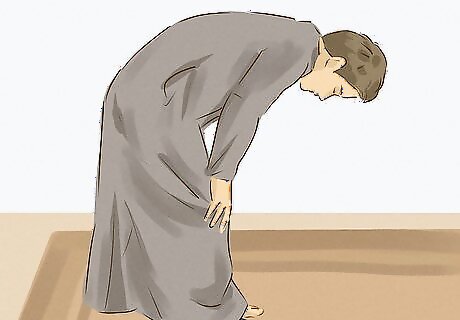
Perform Ruku once the imam is done reciting from the Quran. Ruku is a bowing position, so place your hands on your knees as you bend over. Make your back as parallel to the ground as you can. Keep your eyes focused on the ground. In this position, recite "Subhana Rabbiyal Adhim" (“How perfect is my Lord, the Supreme.”) 3 times.

Stand straight when the imam says “Sami AllahulimanHamidah.” Respond with, “Rabbana lakal Hamd” in a soft voice. This means, “Allah hears those who praise him,” and “Our Lord, praise be to You,” respectively. If you’re the imam at home, recite both yourself.

Go into Sujud the next time the imam says “Allahu Akbar.” Sujud is when you complete a prostration like you do during your normal prayers. Get onto your knees, and place your forehead on the ground in front of you. Recite "Subhana Rabbiyal A’la" 3 times. Then, sit upright and say, “Rabbighfir li,” which means “Oh my Lord! Forgive me.” Repeat this step. This completes the first Rak’ah of Eid.Salah. When in Sujud, keep your hands on the ground near your face, and do not let your elbows or forearms rest on the floor.
The Second Rak’ah

Stand straight after the imam says "Allahu Akbar.” Listen to the imam recite Surah Al Fatiha and another Surah. This is another opportunity for you to listen and reflect on the words of the Holy Quran. Be quiet and respectful during the recitations. You may be tempted to let your attention stray as Eid Salah goes on, but do your best to stay focused and thank Allah for the opportunity of this special day that only comes twice a year.
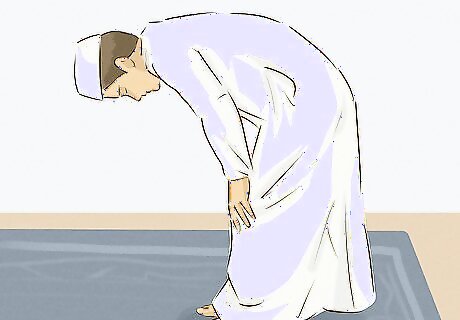
Follow the imam in 3 additional Takbirs and then go back into Ruku. After each of the “Allahu Akbars,” raise your hands. After the third “Allahu Akbar,” go into Ruku, bowing with your hands placed on your knees and your back parallel to the ground. Remember to follow the pacing of the imam and not to rush ahead.

Stand back up after the imam says “Sami AllahulimanHamidah.” Respond with, “Rabbana lakal Hamd” softly. This is the same recitation from the first Raka, meaning, “Allah hears those who praise him,” and “Our Lord, praise be to Yo.”
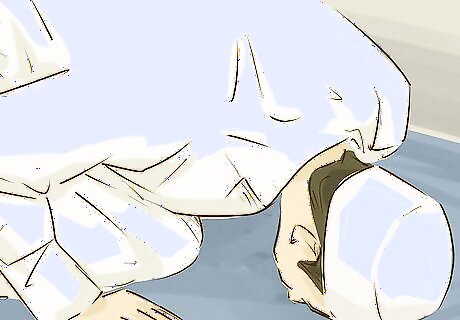
Complete 2 Sujud prostrations after the imam says “Allahu Akbar.” Get onto your knees and place your forehead on the ground in front of you. Keep your hands flat against the ground as well. After you finish the second Sujud, you can stay on the ground rather than standing back up.
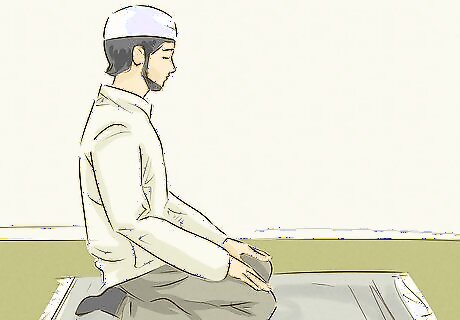
Recite the Tashahhud. This is the testimony of faith. As the imam speaks, reflect on the glory of Allah and the power of the faith of Islam. There are different variants for the Tashahhud, but one version is اَلتَّحِيَّاتُ الْمُبَارَكَاتُ الصَّلَوَاتُ الطَّيِّبَاتُ ِللهِ. اَلسَّلاَمُ عَلَيْكَ أَيُّهَا النَّبِيُّ وَرَحْمَةُ اللهِ وَبَرَكَاتُهُ. اَلسَّلاَمُ عَلَيْنَا وَعَلَى عِبَادِ اللهِ الصَّالِحِيْنَ (At-tahiyyātul mubārakatuṣ-ṣalawātuth ṭayyibātu lillāh. Assalāmu‘alaika ayyuhan-nabiyyu wa rahmatullāhi wa barakātuhu. Assalāmu‘alainā wa ‘alā ‘ibādillāhiṣ-ṣālihīn). After this, send salawat upon the Prophet, as you do when you normally perform Salah.
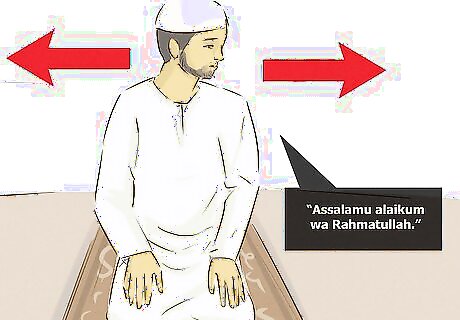
Turn your face to the right and say “Assalamu alaikum wa Rahmatullah.” This means “May the peace and mercy of Allah be with you.” Then turn your face to the left and repeat the prayer again. Wait for the imam to do this before you follow him. This indicates that the prayer has ended.
After Eid Salah
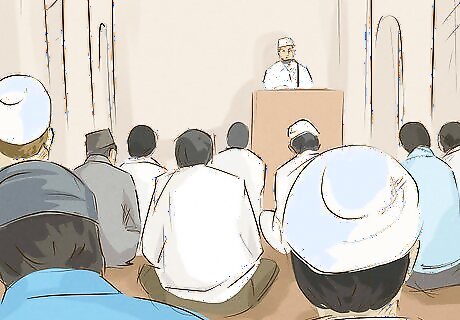
Stay seated and listen to a Khutbah from the imam. The Khutbah generally lasts anywhere from 10-30 minutes with a break in between and addresses different Islamic issues. It is rude to stand up and leave before the imam has finished his Khutbah. It's highly recommended to sit and listen to the Khutbah, and some scholars say that it is obligatory to do so. It's usually discouraged to speak during the Khutbah, just like it's forbidden to do so during the Friday sermon. If you’re praying at home, there won’t be a Khutbah.

Stand and greet your family at the end of Eid Salah. Say hello and give good wishes to your family, and then head to your celebration. Many families have large feasts and give presents on Eid Salah. This is also a great time to get together with extended family. Eid is only twice a year, so it’s a special occasion!
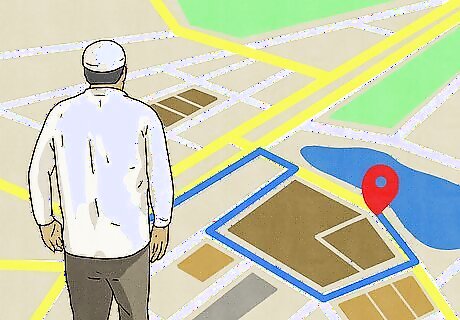
Take a different route home than the one you took to arrive at prayer. It’s customary to take a different path home because the Prophet himself would take 2 different routes when coming and going from Eid prayer. Take this time to reflect on the Salah, and to enjoy the company of your family.




















Comments
0 comment